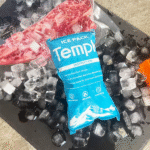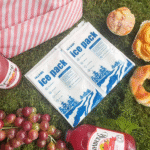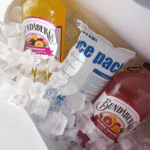Menemukan a es balok kering murah untuk pengiriman bukan hanya soal harga — Anda perlu menyeimbangkan biaya, kinerja dan keselamatan. Es kering (karbon dioksida padat) menjaga barang beku di bawah – 109,3°F (– 78,5°C) dan sangat cocok untuk pengiriman es krim, makanan laut dan obat-obatan, namun blok yang salah dapat merusak kiriman Anda atau melanggar peraturan. Panduan ini menjelaskan cara memilih, gunakan dan hemat balok es kering 2025, mencakup penetapan harga, aturan ukuran, keamanan, pilihan alternatif dan tren rantai dingin terkini.

Apa yang membuat balok es kering efektif untuk pengiriman barang beku?
Berapa banyak es kering yang Anda butuhkan dan berapa biayanya?
Aturan keselamatan dan peraturan apa yang berlaku saat mengirimkan balok es kering?
Kapan sebaiknya Anda memilih kemasan gel daripada es kering, dan apa saja opsi hybrid?
Dimana bisa beli es kering balok yang murah dan berapa harga umumnya?
Apa 2025 tren membentuk pasokan es kering, keberlanjutan dan logistik rantai dingin?
Apa Itu Es Balok Kering dan Mengapa Anda Membutuhkannya untuk Pengiriman?
Dasar-dasar es kering
Es kering adalah bentuk padat karbon dioksida yang menyublim langsung menjadi gas, bukan meleleh menjadi cair. Ia mempertahankan suhu permukaan yang sangat rendah sekitar –109,3°F (–78.5 ° C.), menjadikannya ideal untuk menjaga produk tetap beku selama pengangkutan. Karena itu menyublim (berubah menjadi gas) bukannya meleleh, ada tidak ada sisa air, mengurangi risiko paket basah. Es kering menyediakan Kontrol suhu yang tepat, itulah sebabnya biasanya digunakan untuk pengiriman makanan beku, sampel farmasi dan biologi.
Manfaat menggunakan es balok kering untuk pengiriman barang beku
Pengiriman dengan balok es kering menawarkan manfaat unik:
Waktu pembekuan yang diperpanjang: Suhu es kering yang sangat rendah membuat produk membeku lebih lama dibandingkan kemasan gel, memperlambat pertumbuhan bakteri dan memperpanjang umur simpan.
Tidak beracun dan bebas residu: Es kering disublimasi menjadi gas karbon dioksida, tidak meninggalkan residu cairan yang dapat mengkontaminasi produk.
Mengurangi persyaratan pengemasan: Karena tidak meninggalkan cairan, Anda tidak memerlukan lapisan penyerap atau kemasan sekunder tambahan.
Keserbagunaan: Es kering dapat digunakan di udara, angkutan darat dan laut dan cocok untuk makanan, obat-obatan dan pengiriman industri.
Meskipun terdapat manfaat-manfaat ini, es kering diatur sebagai bahan berbahaya dan memerlukan pengukuran dan pelabelan yang cermat. Bagian selanjutnya menjelaskan cara memilih jumlah yang tepat dan meminimalkan biaya.
Representasi visual
Ilustrasi ini menunjukkan balok es kering yang mengeluarkan uap di dalam kotak berinsulasi dengan sebuah kemasan. Ikon-ikon tersebut menunjukkan logistik rantai dingin, menunjukkan bahwa es kering memastikan barang beku tetap berada dalam suhu aman selama transit.
Meja: Es kering vs.. sekilas tentang paket gel
| Metode pendinginan | Kisaran Suhu Khas | Residu | Biaya Rata-Rata (per pon/bungkus) | Beban Peraturan | Penggunaan terbaik |
| Balok es kering | ≈ –109°F (–78.5 ° C.) | Tidak ada (menyublim menjadi gas) | ~US$1,60–3,00 per pon ditambah ~$8 per biaya pengiriman | Kelas 9 label berbahaya; harus menandai UN1845 | Pengiriman daging beku, es krim, vaksin, Sampel biologis |
| Paket gel | 32–35°F (0–2°C) | Residu cair mungkin terjadi | US$2–5 per bungkus | Tidak ada peraturan khusus | Makanan dingin, Farmasi; dapat digunakan kembali |
| Paket es air | 32–40°F (0–4 ° C.) | Residu air | Rendah (<US$1 per bungkus) | Tidak ada peraturan khusus | Pengiriman jangka pendek dimana pembekuan tidak diinginkan |
Berapa banyak es kering yang Anda butuhkan? Faktor Ukuran dan Biaya
Balok es kering bukanlah satu ukuran yang cocok untuk semua. Terlalu sedikit dan produk Anda mungkin mencair; terlalu banyak dan Anda membuang-buang uang atau berisiko menimbulkan masalah peraturan. Inilah cara melakukannya dengan benar.
Ukuran aturan praktis
Menurut Perusahaan Produk Terisolasi, untuk pengiriman semalam Anda harus menggunakan setengah berat produk Anda dalam es kering; es kering dan produk dengan berat yang sama menyediakan hingga 48 jam pembekuan, dan untuk jalur 72 jam yang mungkin Anda perlukan 1.5 kali berat produk dalam es kering. Perusahaan juga menyarankan penggunaan 5–10 pon es kering per hari untuk pengirim ukuran menengah, tergantung pada isolasi wadah dan suhu lingkungan. EPS padat atau panel berinsulasi vakum (VIP) membutuhkan lebih sedikit es kering; kotak bergelombang tipis atau rute panas membutuhkan lebih banyak.
Penggerak biaya untuk es kering masuk 2025
Analisis harga terperinci yang dilakukan Tempk mengidentifikasi faktor-faktor pendorong biaya utama 2025:
Harga per pon: Es kering eceran umumnya berada di antara keduanya US$1,60 dan US$3,00 per pon. Pembelian dalam jumlah besar melalui pemasok dapat menurunkan tarif ini.
Biaya operator: Banyak maskapai penerbangan mengenakan biaya a biaya es kering datar sekitar US$8 per paket.
Tingkat sublimasi: Rencanakan 5–10 pon es kering per 24 jam transit tergantung pada isolasi dan panas lingkungan.
Kualitas isolasi: Meningkatkan dari dinding bergelombang tipis ke isolasi EPS atau VIP bernilai R tinggi sering kali lebih murah daripada mengirimkan es kering ekstra berat.
Tingkatan pemasok: Memesan jumlah yang lebih besar (MISALNYA., 100–lb blok) mengurangi biaya per pon; bermitra dengan pengirim lain dapat membantu mencapai harga berjenjang.
Contoh perhitungan biaya
Analisis Tempk yang sama memberikan contoh anggaran yang menggambarkan bagaimana biaya bertambah:
Contoh A (2udara siang hari, EPS) - - 6 pon es kering × $1.80 = $10.80 es + ~$8 biaya operator + $3 bahan = kira-kira $21–23.
Contoh B (4tanah hari, bergelombang) - - 18 pon es kering × $1.60 = $28.80 + hingga $8 biaya + $3.50 bahan = $32–40.
Contoh C (3udara siang hari, rute panas) - - 29 pon es kering × $2.20 = $64 + $8 biaya + $3.50 bahan ≈ $75. Meningkatkan isolasi dapat mengurangi massa es kering yang dibutuhkan dan total biaya.
Memahami harga per pon dan biaya tersembunyi
Beberapa pemasok menjual blok seberat 50 pon dengan harga sekitar $60 (US$1,20/pon) atau setengah blok (≈25 pon) untuk $35. Program pembelian universitas terkadang menawarkan es kering di $0.84 per pon, namun harga ini biasanya terbatas untuk penggunaan laboratorium dan tidak tersedia untuk pengiriman komersial. Selalu verifikasi apakah harga yang dikutip sudah termasuk kemasan, penanganan, dan biaya tambahan bahan berbahaya khusus. Beberapa vendor juga mengenakan biaya tambahan untuk pengiriman akhir pekan atau lokasi terpencil.
Es kering kalkulator dapat membantu Anda menyesuaikan ukuran pesanan Anda. Panduan Tempk merekomendasikan rumus sederhana:
Diperkirakan es kering (lb) = Basis × Hari Transit × Faktor Isolasi × Faktor Lingkungan
Di mana Basis adalah 5 lb/hari untuk EPS atau 8 lb/hari untuk bergelombang, Faktor Isolasi mencerminkan ketebalan dinding (1.0 untuk EP, 1.5–1.8 untuk bergelombang) Dan Faktor Lingkungan memperhitungkan cuaca (1.0 untuk ringan, 1.2 untuk panas, 1.3 untuk gelombang panas). Estimator ini memberikan titik awal; gunakan pencatat data pada pengiriman sebenarnya untuk memvalidasi paket Anda dan menyesuaikan sesuai kebutuhan.
Tips Praktis
Muatan pra-pembekuan: Memulai dengan muatan yang sepenuhnya beku akan mengurangi beban pada es kering. Untuk jalur panas, disarankan untuk melakukan pra-pembekuan ditambah 20–30% buffer es kering.
Penempatan es terpisah: Sebarkan es kering di sepanjang dinding dan tutupnya untuk meminimalkan titik panas.
Kombinasikan dengan paket gel: Menambahkan paket gel di sekitar balok es kering dapat memperlambat sublimasi dan memperluas cakupan.
Mengesahkan: Jalankan pengujian berwaktu dengan pencatat data dan sesuaikan bobotnya.
Keamanan, Penyimpanan dan Peraturan Pengiriman Es Balok Kering
Menangani bahaya
Es kering sangat dingin. Kontak dengan kulit telanjang dapat menyebabkan radang dingin yang parah; selalu gunakan penjepit dan kenakan sarung tangan berinsulasi. Jangan biarkan es kering bersentuhan langsung dengan produk; bungkus dengan koran atau lembaran bergelombang dan sisakan ruang yang cukup untuk ekspansi gas.
Penyimpanan dan pembuangan
Simpan es kering di a berventilasi baik, wadah terisolasi (kotak pendingin atau khusus). Jangan menyimpannya dalam wadah kedap udara — sublimasi menghasilkan gas CO₂ yang dapat menimbulkan tekanan dan menyebabkan wadah pecah. Jauhkan dari sinar matahari langsung dan sumber panas, dan selalu tangani dengan sarung tangan atau penjepit. Untuk membuang sisa es kering, biarkan menyublim di tempat yang berventilasi; jangan pernah membuang es kering di wastafel atau perlengkapan lainnya karena suhu dingin yang ekstrem dapat merusak pipa ledeng.
Pertimbangan peraturan
Es kering diklasifikasikan sebagai a bahan berbahaya di Amerika. Untuk pengiriman non medis, paket berisi lebih dari 5.5 pound (2.5 kg) es kering harus mematuhi Judul 49 dari Kode Peraturan Federal (49 CFR) atau Asosiasi Transportasi Udara Internasional (Iata) aturan. Pengiriman di bawah ambang batas ini hanya memerlukan sedikit penandaan, asalkan isinya tidak berbahaya. Persyaratan pelabelan utama meliputi:
Tandai kemasannya sebagai “Karbon Dioksida, padat” atau “Es Kering”.
Sertakan nomor PBB (UN1845) dan berat bersih dalam kilogram (MISALNYA., 6.0 kg).
Terapkan Kelas 9 label bahan berbahaya pada sisi vertikal paket.
Gunakan kemasan ventilasi dan pergi 10–15% ruang kepala untuk memungkinkan gas keluar. Melakukan bukan menempelkan ventilasi.
Kegagalan untuk mengikuti aturan ini dapat mengakibatkan denda, pengiriman yang ditolak atau cedera. Bila ragu, konsultasikan dengan manual barang berbahaya operator Anda.
Balok Es Kering vs. Paket Gel dan Alternatif Lainnya
Membandingkan agen pendingin
Es kering tidak selalu merupakan pilihan terbaik. Paket gel, paket air dan bahan pengubah fasa yang dapat digunakan kembali (PCMS) memberikan suhu dingin tanpa pembekuan. Itu Relokalisasikan Panduan Pembeli merangkum trade offnya: kemasan gel mempertahankan suhu 2–8°C selama 24–48 jam dan tidak beracun tetapi dapat bocor jika ditusuk; paket air lebih murah tetapi memiliki massa termal lebih rendah; paket yang dapat digunakan kembali tahan lama tetapi memerlukan logistik pengembalian. Penawaran es kering suhu yang sangat rendah dan pendinginan yang lebih lama tetapi mahal dan diatur.
Ketika paket gel adalah pilihan yang lebih baik
Paket gel atau air cocok digunakan saat Anda perlu menyimpan produk dinginkan (2–8 ° C.) bukannya dibekukan, misalnya untuk produk segar, coklat atau beberapa obat-obatan. Mereka punya tidak ada klasifikasi berbahaya, jadi tidak perlu label PBB atau pelatihan hazmat. Paket gel juga dapat digunakan kembali dan tidak memerlukan pembuangan khusus.
Menurut Coldkeepers 2025 artikel, Kerugian utama dari es kering mencakup risiko pendinginan berlebih pada barang-barang sensitif, sublimasi cepat (sering 12–24 jam kehidupan efektif) Dan biaya tambahan karena penanganan khusus dan persyaratan peraturan. Paket gel menghindari masalah ini dan oleh karena itu direkomendasikan bagi pelanggan yang tidak terbiasa menangani es kering atau mengirimkan produk non-beku.
Paket hibrida dan teknologi alternatif
Menggabungkan es kering dengan kemasan gel atau PCM dapat menghasilkan a profil pendinginan bertahap: paket gel membantu menjaga suhu dingin setelah es kering menyublim, mengurangi risiko pencairan dan memperpanjang cakupan. Paket hibrida biasa digunakan untuk pengiriman vaksin dan terapi sel, di mana operator memerlukan fase deep freeze dan chilled selama transit.
Alternatif lain yang muncul termasuk unit pendingin mekanis (wadah aktif) dan ditingkatkan panel isolasi vakum (VIP). Kontainer aktif memberikan kontrol suhu yang lebih lama tanpa es kering tetapi memiliki biaya sewa yang lebih tinggi. Baru PCM berbasis bio memberikan rentang suhu yang sempit (MISALNYA., 2–8°C atau 15–25°C) dan digunakan untuk mengurangi konsumsi es kering dalam logistik farmasi.
Tempat Beli Es Balok Kering Murah dan Harga Khas
Contoh harga dari pemasok nyata
Harga bervariasi menurut pemasok, wilayah dan kuantitas. Berikut beberapa contohnya:
Pabrik Es – menjual es balok kering (sekitar 50 lb) untuk $60, setengah blok untuk $35, 3irisan inci untuk $24, dan irisan 1 inci untuk $10. Pelet adalah $1.50 per pon.
Pemasok universitas (Universitas Washington, St. Louis) – menjual es kering seharga $0.84 per pon untuk keperluan laboratorium (terbatas pada pengguna internal).
Kisaran ritel yang khas – US$1,60–3,00 per pon ditambah $8 biaya es kering per pengiriman.
Pertimbangan membeli
Pilih pemasok yang dapat diandalkan. Perusahaan es kering khusus atau pemasok gas industri menjaga kualitas yang konsisten dan mengikuti praktik yang disetujui FDA. Hindari vendor asing di pasar online, karena sublimasi selama transit dapat menghasilkan es yang lebih sedikit daripada yang dibayarkan.
Tanyakan tentang pesanan minimum dan biaya pengiriman. Banyak pemasok memerlukan a 10–lb minimum dan menambahkan pengiriman berdasarkan jarak atau tingkat layanan.
Pesan dalam jumlah banyak atau bermitra dengan tetangga. Penetapan harga tingkat pemasok dapat mengurangi biaya saat Anda membeli lebih banyak; membagi pesanan yang lebih besar di antara bisnis terdekat akan mengurangi biaya per pon.
Periksa ketersediaan lokal. Beberapa toko kelontong, pemasok pesta dan toko perangkat keras menjual es kering dalam jumlah kecil, tetapi harga mungkin lebih tinggi dan pasokan tidak konsisten.
Tips menghemat biaya
Tingkatkan isolasi. Meningkatkan ke kotak dengan nilai R yang lebih tinggi akan mengurangi massa es kering dan berat pengiriman.
Rencanakan pengiriman untuk bulan-bulan yang lebih dingin atau jalur semalaman. Suhu lingkungan yang lebih rendah mengurangi sublimasi dan memungkinkan Anda menggunakan lebih sedikit es kering.
Gunakan solusi hybrid atau PCM. Dimana pembekuan tidak diperlukan, bahan pengubah fasa dapat mengurangi atau menggantikan es kering, menghilangkan biaya hazmat.
Negosiasikan tarif dan biaya. Untuk pengiriman reguler, menegosiasikan harga es kering dan biaya tambahan operator. Tinjau kontrak setiap triwulan untuk menangkap perubahan pasar.
2025 Tren Logistik Es Kering dan Rantai Dingin
Dinamika pasar dan pemicu stres
Pasar es kering global menghadapi tekanan yang belum pernah terjadi sebelumnya akibat keterbatasan pasokan, volatilitas biaya dan tuntutan keberlanjutan. TermoSafe's 2025 tinjauan industri mencatat bahwa konsumsi es kering telah meningkat 5 % per tahun, ketika Pasokan CO₂ hanya meningkat sekitar 0.5 % setiap tahun. Ketidakcocokan ini menciptakan kekurangan berkala dan lonjakan harga hingga 300 % selama krisis pasokan. Pasar dihargai masuknya US$1,54 miliar 2024 dan diproyeksikan mencapai US$2,73 miliar pada tahun 2017 2032 (CAGR 7.4 %).
Tekanan keberlanjutan semakin memperketat ketersediaan: CO₂ yang digunakan untuk es kering semakin banyak dialihkan ke proyek penangkapan dan penyerapan karbon, memaksa pemasok untuk mencari sumber alternatif.
Respons dan inovasi industri
Pusat produksi yang dilokalkan: Produsen sedang membangun lebih banyak fasilitas regional untuk mengurangi kerugian transportasi dan lebih memenuhi permintaan lokal. Beberapa diantaranya menangkap emisi CO₂ di lokasi pabrik pengolahan makanan untuk menghasilkan es kering yang lebih berkelanjutan.
Strategi pendinginan hibrida: Pengirim mencampurkan es kering dengan bahan pengubah fasa dan meningkatkan isolasi untuk meregangkan setiap pon lebih jauh. Kontrak pasokan jangka panjang menggantikan pembelian spot, memberikan prioritas kepada pengirim makanan dan farmasi dalam jumlah besar selama kekurangan.
Sumber CO₂ berbasis bio: Pabrik bioetanol menangkap CO₂ yang dilepaskan selama fermentasi dan mengubahnya menjadi es kering food grade, menciptakan rantai pasokan karbon yang lebih rendah. Di Inggris, satu persediaan tanaman 30–60 % CO₂ negara, menggambarkan potensi dan risiko produksi berbasis bio yang terkonsentrasi.
Alternatif yang muncul
Dengan kekurangan es kering dan masalah keberlanjutan, alternatif mendapatkan daya tarik:
Paket gel dan PCM – menawarkan suhu dingin yang stabil (2–8 ° C.) dan menghindari peraturan hazmat.
Pendinginan mekanis – wadah aktif yang ditenagai oleh baterai atau sumber eksternal digunakan dalam angkutan udara farmasi, meskipun harganya lebih mahal.
Peningkatan isolasi – panel vakum dan bahan daur ulang di tepi jalan mengurangi penggunaan es kering dan dampak lingkungan.
Tren spesifik sektor
Makanan & pemrosesan daging: Pengirim menggunakan irisan dan pelet yang lebih tipis untuk pendinginan cepat di jalur pemrosesan, sementara blok-blok besar tetap disukai untuk transportasi massal. Investasi pada kotak berinsulasi lebih baik memperpanjang waktu penahanan dan meminimalkan sublimasi.
Farmasi & laboratorium: Pengiriman bahan biologis yang sangat terkontrol, vaksin dan terapi gen sedang menguji teknologi penghalang untuk memperlambat pelepasan gas CO₂ dan menggunakan pemantauan waktu nyata untuk melindungi kargo. Untuk obat-obatan yang kurang kritis, pengirim PCM yang dapat digunakan kembali mengurangi ketergantungan es kering.
Aplikasi industri: Kontraktor peledakan es kering menandatangani kontrak pasokan jangka panjang atau berinvestasi pada kapasitas pembuatan pelet lokal untuk menghindari kekurangan di tempat.
Pertanyaan yang sering diajukan
Q1: Berapa lama es kering murah bertahan saat mengirimkan makanan beku?
Blok seberat 10–20 pon biasanya tahan lama 12–24 jam dalam bergelombang tipis atau hingga 48 jam dalam wadah EPS padat. Rencanakan 5–10 lb per hari tergantung pada isolasi dan suhu lingkungan.
Q2: Lebih murah pakai dry ice atau gel pack untuk pengiriman?
Biaya es kering US$1,60–3,00 per pon ditambah biaya penanganan dan membutuhkan Kelas 9 pelabelan. Biaya paket gel US$2–5 per bungkus, dapat digunakan kembali dan tidak memiliki aturan hazmat. Gunakan kemasan gel untuk pengiriman dingin; pilih es kering untuk pengiriman yang membutuhkan suhu di bawah –18 °C.
Q3: Bagaimana cara membuang es kering setelah pengiriman?
Biarkan sisa es kering menyublim di area yang berventilasi baik, Jauh dari anak -anak dan hewan peliharaan. Jangan pernah meletakkan es kering di wastafel atau ruang tertutup karena suhu dingin yang ekstrim dapat merusak peralatan dan penumpukan CO₂ dapat menggantikan oksigen..
Q4: Bisakah saya mengirim lebih dari itu 5.5 lb es kering tanpa pelatihan hazmat?
TIDAK. Peraturan AS mewajibkan pengiriman berisi lebih dari 5.5 lb (2.5 kg) es kering yang harus dipenuhi 49 CFR atau Iata Pedoman, termasuk pelabelan dan dokumentasi. Di bawah batas itu, hanya diperlukan tanda minimal.
Q5: Dimana saya bisa membeli es kering balok yang murah?
Pemasok industri seringkali memberikan nilai terbaik. Misalnya, Pabrik Es menjual balok seberat 50 pon seharga $60 dan setengah blok untuk $35. Program pembelian universitas mungkin menawarkan harga sekitar $0.84 per pon, tetapi biasanya terbatas pada penggunaan internal. Selalu periksa jumlah pesanan minimum dan biaya operator.
Ringkasan dan Rekomendasi
Pahami kebutuhan suhu Anda. Balok es kering sangat diperlukan untuk pengiriman yang memerlukan suhu di bawah –18 °C, tetapi kemasan gel atau air cukup untuk pengiriman dingin.
Ukuran dan biaya hati-hati. Terapkan heuristik 5–10 lb/hari dan sesuaikan dengan insulasi dan iklim. Harapkan harga eceran sekitar US$1,60–3,00 per pon ditambah biaya.
Ikuti aturan keselamatan dan peraturan. Kenakan sarung tangan terisolasi, simpan dalam wadah berventilasi, dan beri label paket dengan UN1845 bila perlu.
Pertimbangkan alternatif dan strategi hibrida. Paket gel, bahan pengubah fasa dan insulasi yang lebih baik dapat mengurangi penggunaan dan biaya es kering.
Tetap terinformasi tentang tren pasar. Kendala pasokan dan tekanan keberlanjutan dapat mempengaruhi ketersediaan es kering; diversifikasi strategi rantai dingin Anda dengan menjajaki pemasok lokal dan kontrak jangka panjang.
Rencana aksi
Menilai persyaratan produk. Tentukan apakah barang Anda memerlukan suhu beku atau dingin.
Perkirakan berat es kering. Gunakan rumusnya (Basis × hari × isolasi × lingkungan) sebagai titik awal dan melakukan uji coba dengan data logger.
Sumber dari pemasok terkemuka. Bandingkan distributor es kering lokal, perusahaan gas industri dan pemasok khusus. Verifikasi harga sudah termasuk biaya dan tanyakan tentang diskon massal.
Tingkatkan isolasi jika memungkinkan. Berinvestasi pada kotak yang lebih baik dapat menghemat lebih banyak daripada yang dibutuhkan es kering ekstra.
Kepatuhan dokumen. Siapkan label, Nomor PBB dan persyaratan headspace sebelum pengiriman untuk menghindari penundaan dan penalti.
Tentang tempk
Tempk (Shanghai Huizhou Industri Co.) adalah a spesialis pengemasan rantai dingin berkantor pusat di Shanghai dengan berbagai fasilitas global. Perusahaan merancang dan memproduksi paket es gel, batu bata freezer, ransel terisolasi, Kotak VIP dan penutup palet untuk makanan, pengiriman farmasi dan biologi. Dengan fokus penelitian dan inovasi, Tempk mengembangkan produk rantai dingin yang dapat digunakan kembali dan didaur ulang serta menawarkan solusi khusus untuk perusahaan farmasi besar. Dengan menggabungkan isolasi nilai R tinggi dengan Teknologi PCM, Tempk membantu klien mengurangi penggunaan es kering dengan tetap menjaga integritas produk.
Langkah selanjutnya: Hubungi tim Tempk untuk mendiskusikan kebutuhan pengiriman spesifik Anda dan mencari tahu efektivitas biaya, solusi berkelanjutan untuk operasi rantai dingin Anda.






















